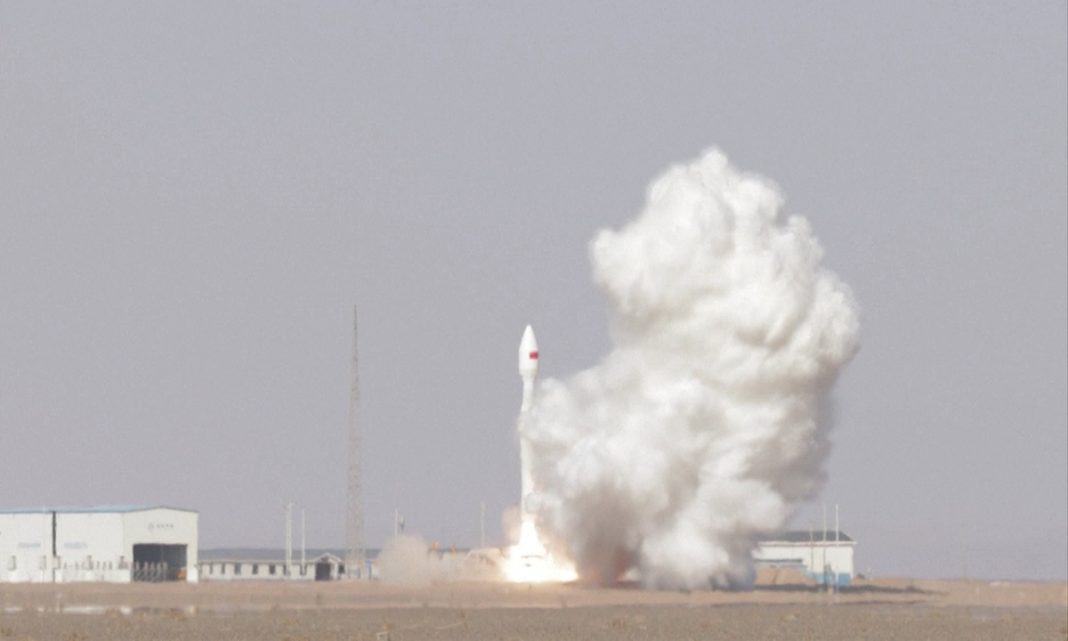BEIJING: China’s Kinetica-1 rocket, also known as Lijian-1, carried out its ninth launch at 11:33 am on Sunday from the Dongfeng Commercial Aerospace innovation test zone, successfully sending three satellites, including one remote sensing satellite from Pakistan, into their preset orbits, the Global Times learned from rocket developer CAS Space on Sunday.
The successful launch of the satellite is seen as “a major milestone” in Pakistan’s aerospace development, according to Radio Pakistan on Sunday. Developed by the Pakistan Space and Upper Atmosphere Research Commission, the satellite is equipped with advanced hyperspectral imaging technology capable of capturing data across hundreds of spectral bands.
The satellite is expected to significantly enhance Pakistan’s national capacities in areas such as precision agriculture, environmental monitoring, urban planning and disaster management. Its high-resolution data will support improved resource management and strengthen Pakistan’s resilience to climate-related challenges, the report said.
China has been cooperating extensively with Pakistan in aerospace in recent years. Last year China launched the epic Chang’e-6 lunar exploration mission, carrying with it four international projects, including one from Pakistan – the country’s first ever CubeSat.
In February this year, the China Manned Space Agency and the Pakistan Space & Upper Atmosphere Research Commission signed a cooperation agreement on selecting and training Pakistani astronauts for future flight missions to China’s Tiangong space station, opening a new chapter in deepening cooperation in manned space sector between the two countries.
The move marked China’s first step in selecting and training foreign astronauts to participate in the country’s space station flight missions.
During Sunday’s flight mission, two satellites developed by Airsat Technology Group were also placed into their designated orbits. They are X-band SAR remote sensing satellites operating in a sun-synchronous frozen regression orbit at an altitude of 505 kilometers, according to a statement CAS Space sent to the Global Times.
Their primary payload is a lightweight X-band SAR system, the first in China to utilize a Cassegrain dual-reflector antenna design, offering a more compact structure. These satellites are equipped with interferometric SAR measurement capabilities and onboard AI processing, achieving an imaging resolution better than 0.5 meters, per the statement.
With a total weight of less than 270 kilograms, they can perform SAR imaging for up to 5 minutes per orbit, a leading capability in China.
Following their successful orbit insertion, the two satellites will be integrated into the Airsat constellation, providing robust support for SAR remote sensing data applications in fields such as natural resources, agriculture, rural development, emergency disaster prevention, water conservancy and urban planning, the statement said.
Sunday’s mission marks the ninth flight of the Kinetica-1 carrier rocket. To date, it has accurately delivered 73 satellites into their designated orbits, with a total payload mass exceeding 9 tons.
CAS Space, a leading commercial rocket maker in China, said it has actively expanded into international markets, becoming the only Chinese commercial rocket to achieve overseas payload launches. In August, CAS Space delivered seven satellites to orbit, including a pair of femtosats (ultra-small, low-mass spacecraft), marking the company’s first launch of payloads for a Latin American client, according to China News Service It previously launched a satellite for Oman, representing its first foreign customer, in November 2024, per Xinhua News Agency.
The Kinetica-1 model, with a length of 30 meters, a diameter of 2.65 meters, and a liftoff weight of 135 tons, is capable of deploying satellites with a combined weight of 1.5 tons to a typical sun-synchronous orbit about 500 kilometers above Earth. The Kinetica-2, a liquid propellent carrier rocket, is expected to debut this year. It has a larger load capacity to cut costs in space cargo transport and constellation deployment, and will be the main launch vehicle for Qingzhou cargo spacecraft, the country’s next-generation cargo craft designed for future in-orbit supply delivery to the space station. –The Daily Mail-Global Times news exchange item
Home CHINA-CPEC-BRI China’s Kinetica-1 rocket sends Pakistan’s first hyperspectral satellite into orbit






